Evaluating Employment Relations in Singapore: Unitary or Pluralist?
VerifiedAdded on 2023/06/03
|8
|2635
|471
Essay
AI Summary
This essay explores employment relations in Singapore, examining whether businesses adopt a unitary or pluralist approach. The unitary approach emphasizes cooperation and harmony between employers and employees, with management holding authority, while the pluralist approach acknowledges potential conflicts due to differing interests and advocates for regulations and trade unions to balance power. Singapore's context, including issues like unemployment and layoffs, is analyzed to determine if the unitary approach is justified or if a shift towards pluralism is occurring. The role of the National Trades Union Congress (NTUC) and the Singapore National Employers Federation (SNEF) are discussed as examples of pluralist elements. The essay also references Accenture as a company that successfully implements a pluralist approach. Singapore's pro-employer labor regime and the government's efforts to provide a harmonious work environment are considered, along with key legislation like the Employment Act 1968. The essay concludes that a pluralist approach is more appropriate for employee relations in Singapore, supported by company examples and government initiatives.
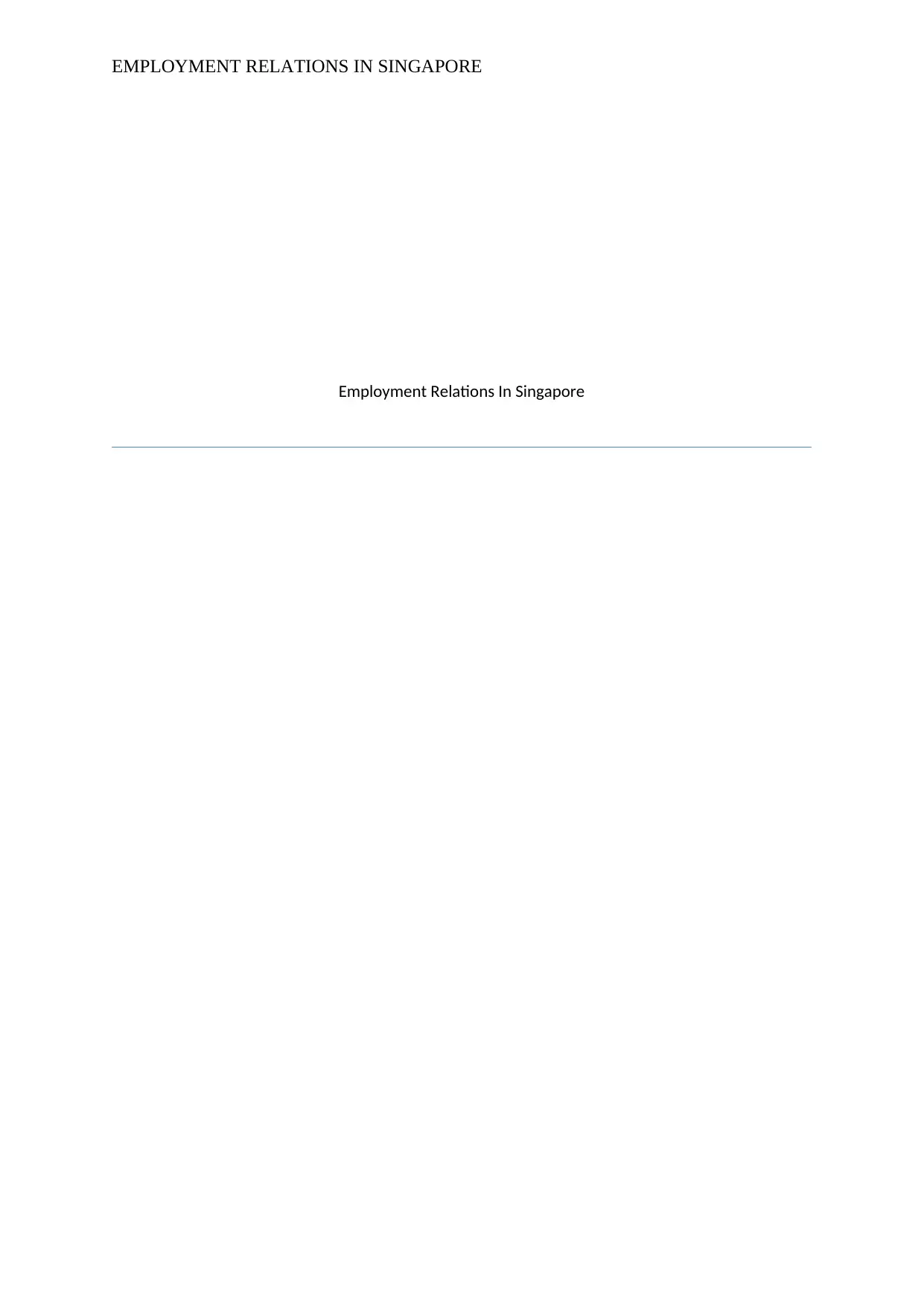
EMPLOYMENT RELATIONS IN SINGAPORE
Employment Relations In Singapore
Employment Relations In Singapore
Paraphrase This Document
Need a fresh take? Get an instant paraphrase of this document with our AI Paraphraser
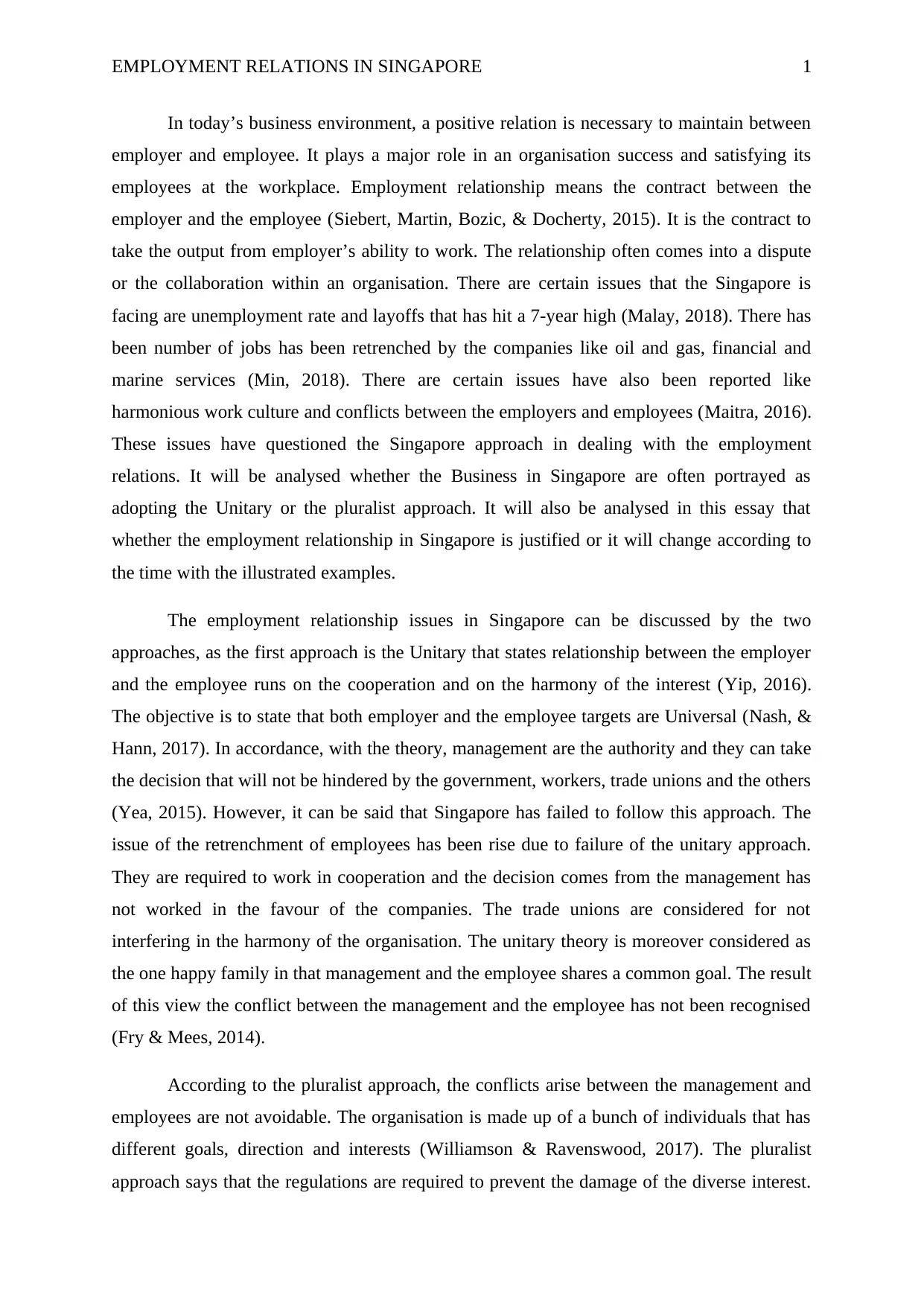
EMPLOYMENT RELATIONS IN SINGAPORE 1
In today’s business environment, a positive relation is necessary to maintain between
employer and employee. It plays a major role in an organisation success and satisfying its
employees at the workplace. Employment relationship means the contract between the
employer and the employee (Siebert, Martin, Bozic, & Docherty, 2015). It is the contract to
take the output from employer’s ability to work. The relationship often comes into a dispute
or the collaboration within an organisation. There are certain issues that the Singapore is
facing are unemployment rate and layoffs that has hit a 7-year high (Malay, 2018). There has
been number of jobs has been retrenched by the companies like oil and gas, financial and
marine services (Min, 2018). There are certain issues have also been reported like
harmonious work culture and conflicts between the employers and employees (Maitra, 2016).
These issues have questioned the Singapore approach in dealing with the employment
relations. It will be analysed whether the Business in Singapore are often portrayed as
adopting the Unitary or the pluralist approach. It will also be analysed in this essay that
whether the employment relationship in Singapore is justified or it will change according to
the time with the illustrated examples.
The employment relationship issues in Singapore can be discussed by the two
approaches, as the first approach is the Unitary that states relationship between the employer
and the employee runs on the cooperation and on the harmony of the interest (Yip, 2016).
The objective is to state that both employer and the employee targets are Universal (Nash, &
Hann, 2017). In accordance, with the theory, management are the authority and they can take
the decision that will not be hindered by the government, workers, trade unions and the others
(Yea, 2015). However, it can be said that Singapore has failed to follow this approach. The
issue of the retrenchment of employees has been rise due to failure of the unitary approach.
They are required to work in cooperation and the decision comes from the management has
not worked in the favour of the companies. The trade unions are considered for not
interfering in the harmony of the organisation. The unitary theory is moreover considered as
the one happy family in that management and the employee shares a common goal. The result
of this view the conflict between the management and the employee has not been recognised
(Fry & Mees, 2014).
According to the pluralist approach, the conflicts arise between the management and
employees are not avoidable. The organisation is made up of a bunch of individuals that has
different goals, direction and interests (Williamson & Ravenswood, 2017). The pluralist
approach says that the regulations are required to prevent the damage of the diverse interest.
In today’s business environment, a positive relation is necessary to maintain between
employer and employee. It plays a major role in an organisation success and satisfying its
employees at the workplace. Employment relationship means the contract between the
employer and the employee (Siebert, Martin, Bozic, & Docherty, 2015). It is the contract to
take the output from employer’s ability to work. The relationship often comes into a dispute
or the collaboration within an organisation. There are certain issues that the Singapore is
facing are unemployment rate and layoffs that has hit a 7-year high (Malay, 2018). There has
been number of jobs has been retrenched by the companies like oil and gas, financial and
marine services (Min, 2018). There are certain issues have also been reported like
harmonious work culture and conflicts between the employers and employees (Maitra, 2016).
These issues have questioned the Singapore approach in dealing with the employment
relations. It will be analysed whether the Business in Singapore are often portrayed as
adopting the Unitary or the pluralist approach. It will also be analysed in this essay that
whether the employment relationship in Singapore is justified or it will change according to
the time with the illustrated examples.
The employment relationship issues in Singapore can be discussed by the two
approaches, as the first approach is the Unitary that states relationship between the employer
and the employee runs on the cooperation and on the harmony of the interest (Yip, 2016).
The objective is to state that both employer and the employee targets are Universal (Nash, &
Hann, 2017). In accordance, with the theory, management are the authority and they can take
the decision that will not be hindered by the government, workers, trade unions and the others
(Yea, 2015). However, it can be said that Singapore has failed to follow this approach. The
issue of the retrenchment of employees has been rise due to failure of the unitary approach.
They are required to work in cooperation and the decision comes from the management has
not worked in the favour of the companies. The trade unions are considered for not
interfering in the harmony of the organisation. The unitary theory is moreover considered as
the one happy family in that management and the employee shares a common goal. The result
of this view the conflict between the management and the employee has not been recognised
(Fry & Mees, 2014).
According to the pluralist approach, the conflicts arise between the management and
employees are not avoidable. The organisation is made up of a bunch of individuals that has
different goals, direction and interests (Williamson & Ravenswood, 2017). The pluralist
approach says that the regulations are required to prevent the damage of the diverse interest.
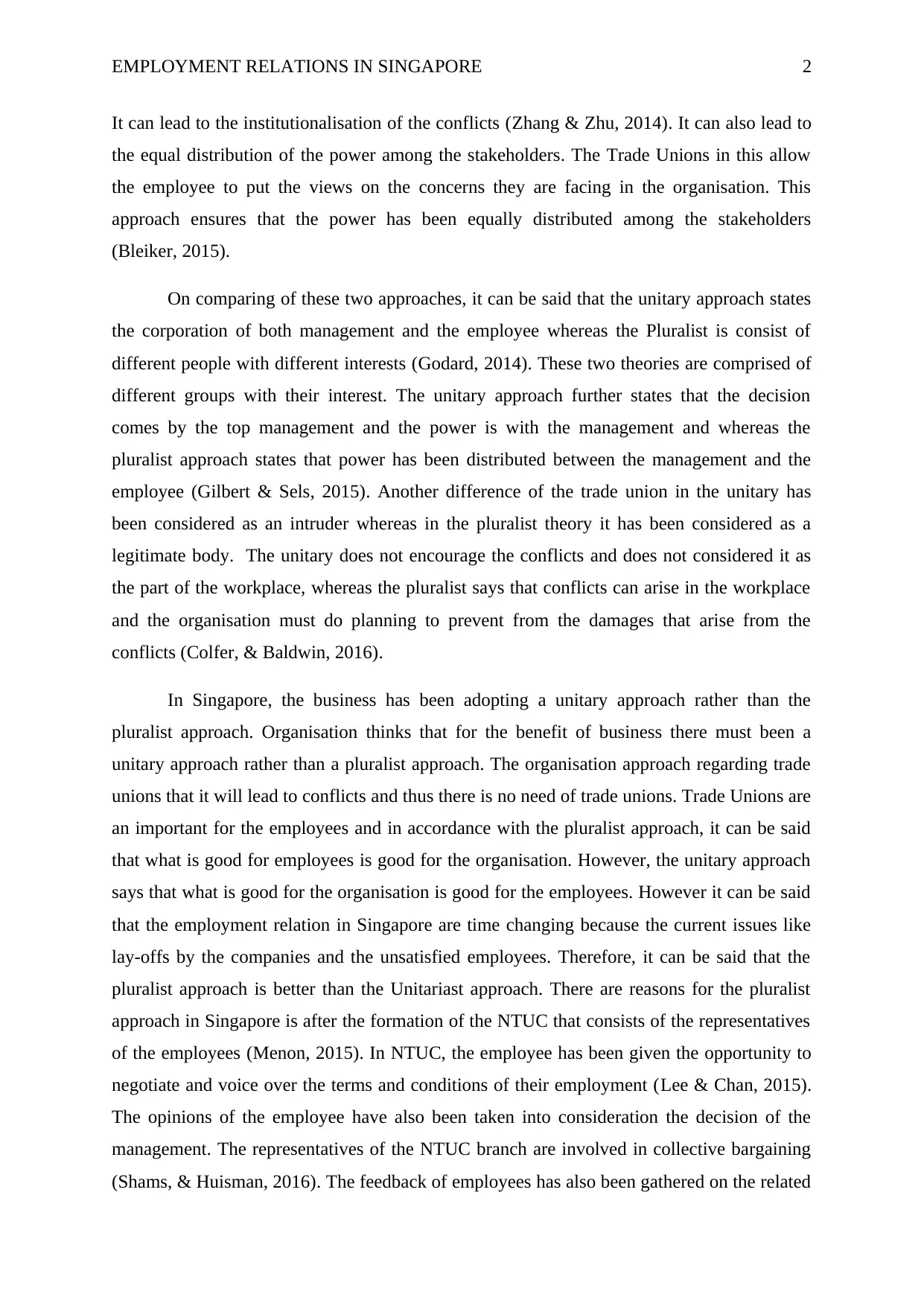
EMPLOYMENT RELATIONS IN SINGAPORE 2
It can lead to the institutionalisation of the conflicts (Zhang & Zhu, 2014). It can also lead to
the equal distribution of the power among the stakeholders. The Trade Unions in this allow
the employee to put the views on the concerns they are facing in the organisation. This
approach ensures that the power has been equally distributed among the stakeholders
(Bleiker, 2015).
On comparing of these two approaches, it can be said that the unitary approach states
the corporation of both management and the employee whereas the Pluralist is consist of
different people with different interests (Godard, 2014). These two theories are comprised of
different groups with their interest. The unitary approach further states that the decision
comes by the top management and the power is with the management and whereas the
pluralist approach states that power has been distributed between the management and the
employee (Gilbert & Sels, 2015). Another difference of the trade union in the unitary has
been considered as an intruder whereas in the pluralist theory it has been considered as a
legitimate body. The unitary does not encourage the conflicts and does not considered it as
the part of the workplace, whereas the pluralist says that conflicts can arise in the workplace
and the organisation must do planning to prevent from the damages that arise from the
conflicts (Colfer, & Baldwin, 2016).
In Singapore, the business has been adopting a unitary approach rather than the
pluralist approach. Organisation thinks that for the benefit of business there must been a
unitary approach rather than a pluralist approach. The organisation approach regarding trade
unions that it will lead to conflicts and thus there is no need of trade unions. Trade Unions are
an important for the employees and in accordance with the pluralist approach, it can be said
that what is good for employees is good for the organisation. However, the unitary approach
says that what is good for the organisation is good for the employees. However it can be said
that the employment relation in Singapore are time changing because the current issues like
lay-offs by the companies and the unsatisfied employees. Therefore, it can be said that the
pluralist approach is better than the Unitariast approach. There are reasons for the pluralist
approach in Singapore is after the formation of the NTUC that consists of the representatives
of the employees (Menon, 2015). In NTUC, the employee has been given the opportunity to
negotiate and voice over the terms and conditions of their employment (Lee & Chan, 2015).
The opinions of the employee have also been taken into consideration the decision of the
management. The representatives of the NTUC branch are involved in collective bargaining
(Shams, & Huisman, 2016). The feedback of employees has also been gathered on the related
It can lead to the institutionalisation of the conflicts (Zhang & Zhu, 2014). It can also lead to
the equal distribution of the power among the stakeholders. The Trade Unions in this allow
the employee to put the views on the concerns they are facing in the organisation. This
approach ensures that the power has been equally distributed among the stakeholders
(Bleiker, 2015).
On comparing of these two approaches, it can be said that the unitary approach states
the corporation of both management and the employee whereas the Pluralist is consist of
different people with different interests (Godard, 2014). These two theories are comprised of
different groups with their interest. The unitary approach further states that the decision
comes by the top management and the power is with the management and whereas the
pluralist approach states that power has been distributed between the management and the
employee (Gilbert & Sels, 2015). Another difference of the trade union in the unitary has
been considered as an intruder whereas in the pluralist theory it has been considered as a
legitimate body. The unitary does not encourage the conflicts and does not considered it as
the part of the workplace, whereas the pluralist says that conflicts can arise in the workplace
and the organisation must do planning to prevent from the damages that arise from the
conflicts (Colfer, & Baldwin, 2016).
In Singapore, the business has been adopting a unitary approach rather than the
pluralist approach. Organisation thinks that for the benefit of business there must been a
unitary approach rather than a pluralist approach. The organisation approach regarding trade
unions that it will lead to conflicts and thus there is no need of trade unions. Trade Unions are
an important for the employees and in accordance with the pluralist approach, it can be said
that what is good for employees is good for the organisation. However, the unitary approach
says that what is good for the organisation is good for the employees. However it can be said
that the employment relation in Singapore are time changing because the current issues like
lay-offs by the companies and the unsatisfied employees. Therefore, it can be said that the
pluralist approach is better than the Unitariast approach. There are reasons for the pluralist
approach in Singapore is after the formation of the NTUC that consists of the representatives
of the employees (Menon, 2015). In NTUC, the employee has been given the opportunity to
negotiate and voice over the terms and conditions of their employment (Lee & Chan, 2015).
The opinions of the employee have also been taken into consideration the decision of the
management. The representatives of the NTUC branch are involved in collective bargaining
(Shams, & Huisman, 2016). The feedback of employees has also been gathered on the related
⊘ This is a preview!⊘
Do you want full access?
Subscribe today to unlock all pages.

Trusted by 1+ million students worldwide
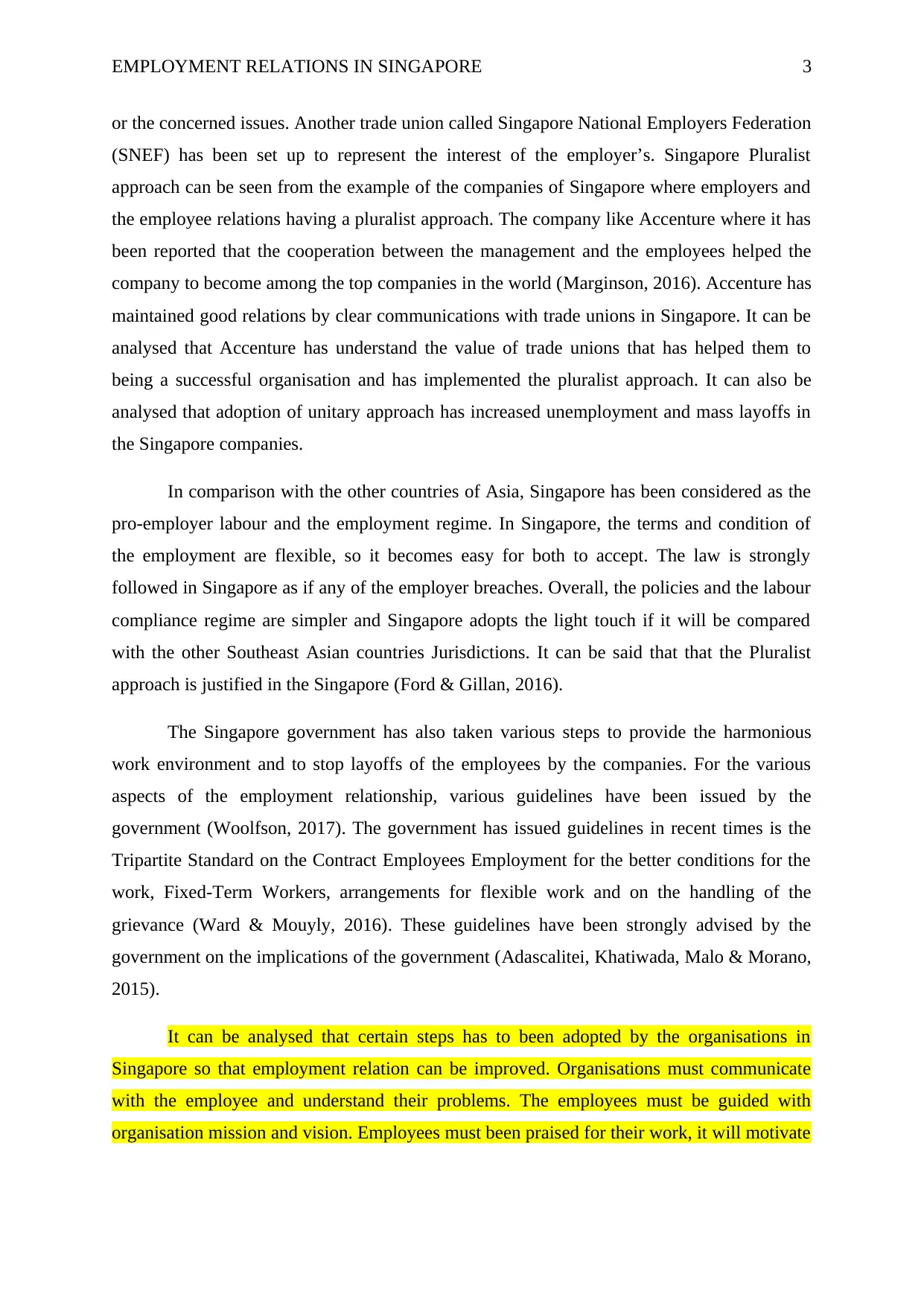
EMPLOYMENT RELATIONS IN SINGAPORE 3
or the concerned issues. Another trade union called Singapore National Employers Federation
(SNEF) has been set up to represent the interest of the employer’s. Singapore Pluralist
approach can be seen from the example of the companies of Singapore where employers and
the employee relations having a pluralist approach. The company like Accenture where it has
been reported that the cooperation between the management and the employees helped the
company to become among the top companies in the world (Marginson, 2016). Accenture has
maintained good relations by clear communications with trade unions in Singapore. It can be
analysed that Accenture has understand the value of trade unions that has helped them to
being a successful organisation and has implemented the pluralist approach. It can also be
analysed that adoption of unitary approach has increased unemployment and mass layoffs in
the Singapore companies.
In comparison with the other countries of Asia, Singapore has been considered as the
pro-employer labour and the employment regime. In Singapore, the terms and condition of
the employment are flexible, so it becomes easy for both to accept. The law is strongly
followed in Singapore as if any of the employer breaches. Overall, the policies and the labour
compliance regime are simpler and Singapore adopts the light touch if it will be compared
with the other Southeast Asian countries Jurisdictions. It can be said that that the Pluralist
approach is justified in the Singapore (Ford & Gillan, 2016).
The Singapore government has also taken various steps to provide the harmonious
work environment and to stop layoffs of the employees by the companies. For the various
aspects of the employment relationship, various guidelines have been issued by the
government (Woolfson, 2017). The government has issued guidelines in recent times is the
Tripartite Standard on the Contract Employees Employment for the better conditions for the
work, Fixed-Term Workers, arrangements for flexible work and on the handling of the
grievance (Ward & Mouyly, 2016). These guidelines have been strongly advised by the
government on the implications of the government (Adascalitei, Khatiwada, Malo & Morano,
2015).
It can be analysed that certain steps has to been adopted by the organisations in
Singapore so that employment relation can be improved. Organisations must communicate
with the employee and understand their problems. The employees must be guided with
organisation mission and vision. Employees must been praised for their work, it will motivate
or the concerned issues. Another trade union called Singapore National Employers Federation
(SNEF) has been set up to represent the interest of the employer’s. Singapore Pluralist
approach can be seen from the example of the companies of Singapore where employers and
the employee relations having a pluralist approach. The company like Accenture where it has
been reported that the cooperation between the management and the employees helped the
company to become among the top companies in the world (Marginson, 2016). Accenture has
maintained good relations by clear communications with trade unions in Singapore. It can be
analysed that Accenture has understand the value of trade unions that has helped them to
being a successful organisation and has implemented the pluralist approach. It can also be
analysed that adoption of unitary approach has increased unemployment and mass layoffs in
the Singapore companies.
In comparison with the other countries of Asia, Singapore has been considered as the
pro-employer labour and the employment regime. In Singapore, the terms and condition of
the employment are flexible, so it becomes easy for both to accept. The law is strongly
followed in Singapore as if any of the employer breaches. Overall, the policies and the labour
compliance regime are simpler and Singapore adopts the light touch if it will be compared
with the other Southeast Asian countries Jurisdictions. It can be said that that the Pluralist
approach is justified in the Singapore (Ford & Gillan, 2016).
The Singapore government has also taken various steps to provide the harmonious
work environment and to stop layoffs of the employees by the companies. For the various
aspects of the employment relationship, various guidelines have been issued by the
government (Woolfson, 2017). The government has issued guidelines in recent times is the
Tripartite Standard on the Contract Employees Employment for the better conditions for the
work, Fixed-Term Workers, arrangements for flexible work and on the handling of the
grievance (Ward & Mouyly, 2016). These guidelines have been strongly advised by the
government on the implications of the government (Adascalitei, Khatiwada, Malo & Morano,
2015).
It can be analysed that certain steps has to been adopted by the organisations in
Singapore so that employment relation can be improved. Organisations must communicate
with the employee and understand their problems. The employees must be guided with
organisation mission and vision. Employees must been praised for their work, it will motivate
Paraphrase This Document
Need a fresh take? Get an instant paraphrase of this document with our AI Paraphraser
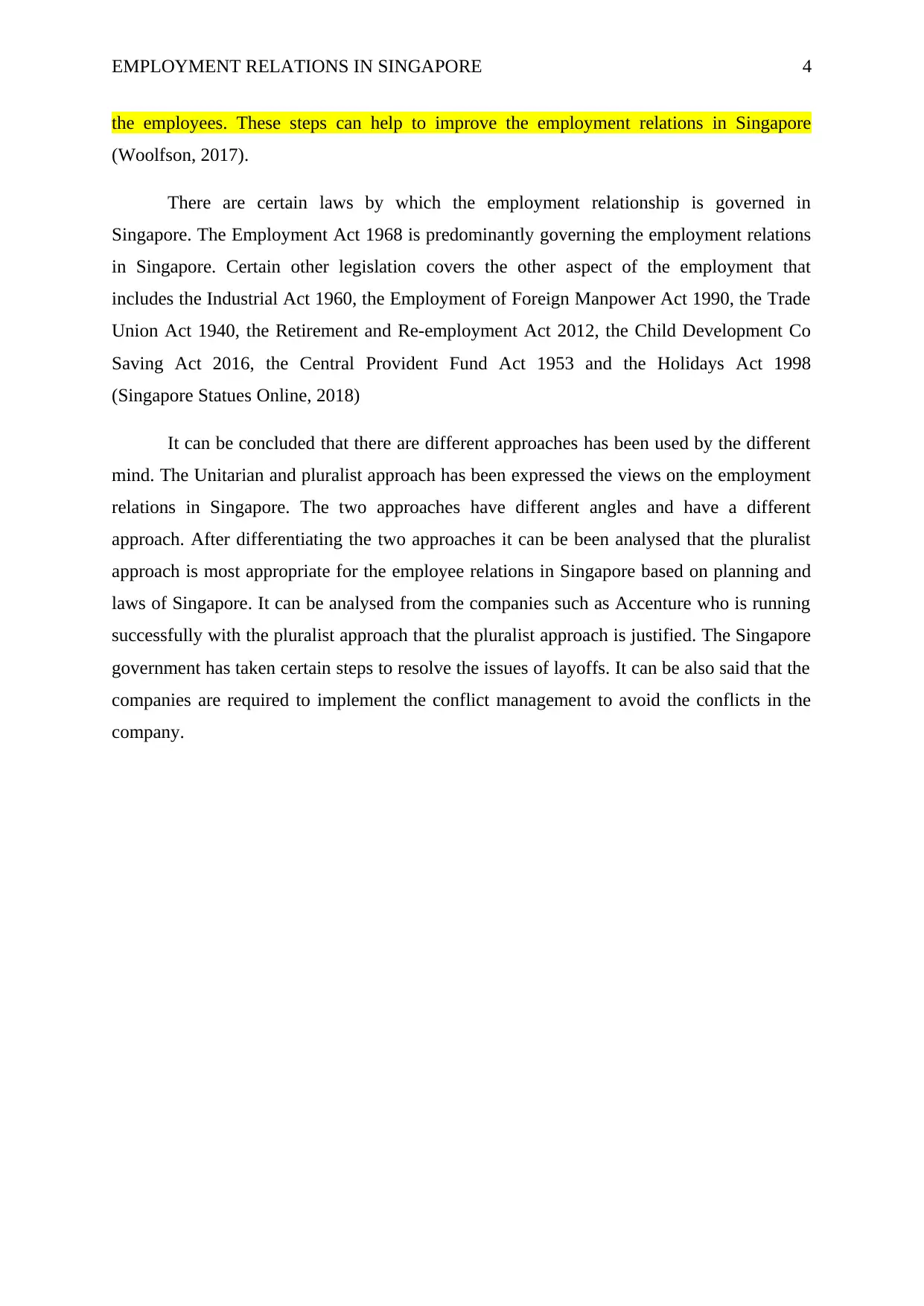
EMPLOYMENT RELATIONS IN SINGAPORE 4
the employees. These steps can help to improve the employment relations in Singapore
(Woolfson, 2017).
There are certain laws by which the employment relationship is governed in
Singapore. The Employment Act 1968 is predominantly governing the employment relations
in Singapore. Certain other legislation covers the other aspect of the employment that
includes the Industrial Act 1960, the Employment of Foreign Manpower Act 1990, the Trade
Union Act 1940, the Retirement and Re-employment Act 2012, the Child Development Co
Saving Act 2016, the Central Provident Fund Act 1953 and the Holidays Act 1998
(Singapore Statues Online, 2018)
It can be concluded that there are different approaches has been used by the different
mind. The Unitarian and pluralist approach has been expressed the views on the employment
relations in Singapore. The two approaches have different angles and have a different
approach. After differentiating the two approaches it can be been analysed that the pluralist
approach is most appropriate for the employee relations in Singapore based on planning and
laws of Singapore. It can be analysed from the companies such as Accenture who is running
successfully with the pluralist approach that the pluralist approach is justified. The Singapore
government has taken certain steps to resolve the issues of layoffs. It can be also said that the
companies are required to implement the conflict management to avoid the conflicts in the
company.
the employees. These steps can help to improve the employment relations in Singapore
(Woolfson, 2017).
There are certain laws by which the employment relationship is governed in
Singapore. The Employment Act 1968 is predominantly governing the employment relations
in Singapore. Certain other legislation covers the other aspect of the employment that
includes the Industrial Act 1960, the Employment of Foreign Manpower Act 1990, the Trade
Union Act 1940, the Retirement and Re-employment Act 2012, the Child Development Co
Saving Act 2016, the Central Provident Fund Act 1953 and the Holidays Act 1998
(Singapore Statues Online, 2018)
It can be concluded that there are different approaches has been used by the different
mind. The Unitarian and pluralist approach has been expressed the views on the employment
relations in Singapore. The two approaches have different angles and have a different
approach. After differentiating the two approaches it can be been analysed that the pluralist
approach is most appropriate for the employee relations in Singapore based on planning and
laws of Singapore. It can be analysed from the companies such as Accenture who is running
successfully with the pluralist approach that the pluralist approach is justified. The Singapore
government has taken certain steps to resolve the issues of layoffs. It can be also said that the
companies are required to implement the conflict management to avoid the conflicts in the
company.
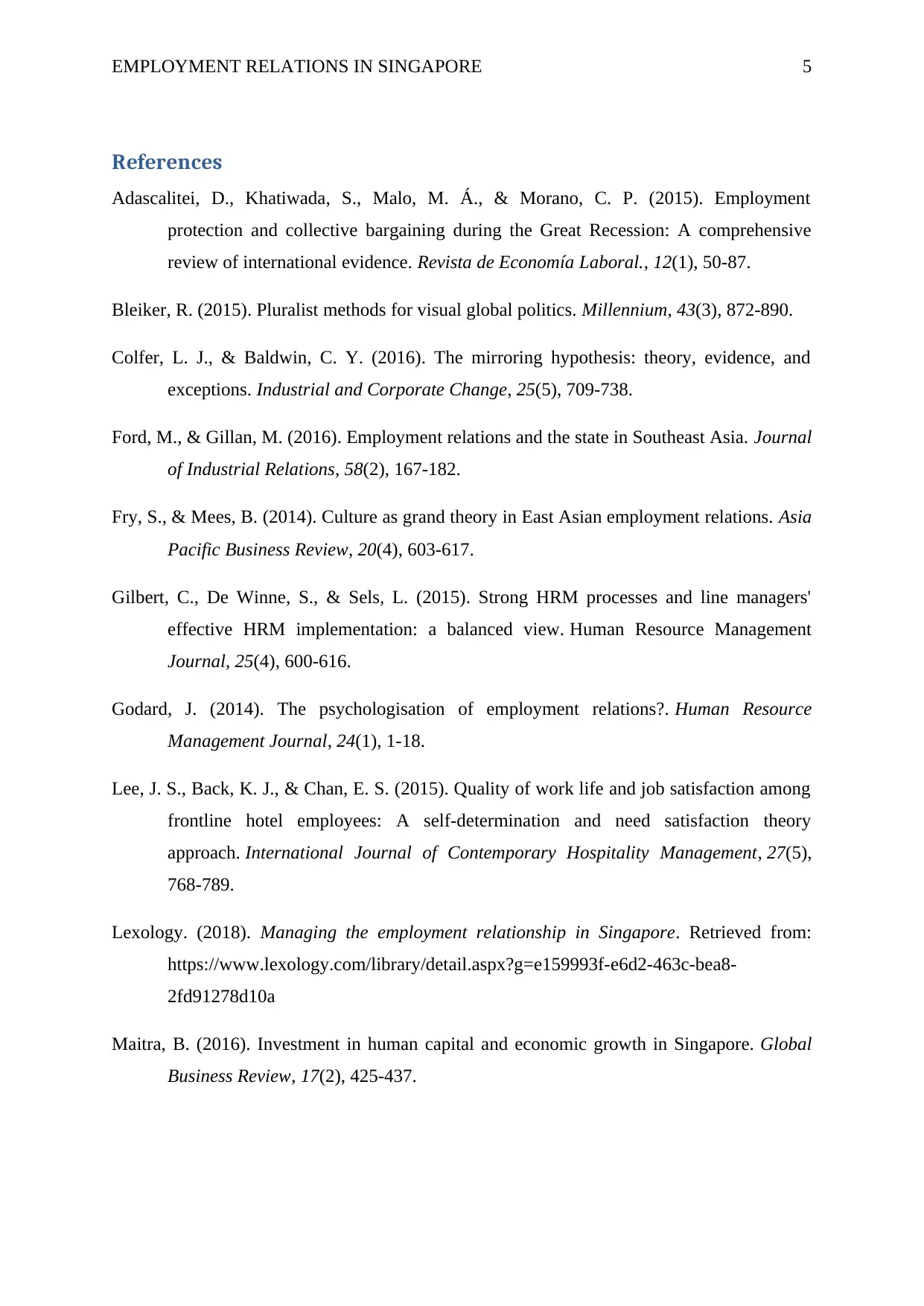
EMPLOYMENT RELATIONS IN SINGAPORE 5
References
Adascalitei, D., Khatiwada, S., Malo, M. Á., & Morano, C. P. (2015). Employment
protection and collective bargaining during the Great Recession: A comprehensive
review of international evidence. Revista de Economía Laboral., 12(1), 50-87.
Bleiker, R. (2015). Pluralist methods for visual global politics. Millennium, 43(3), 872-890.
Colfer, L. J., & Baldwin, C. Y. (2016). The mirroring hypothesis: theory, evidence, and
exceptions. Industrial and Corporate Change, 25(5), 709-738.
Ford, M., & Gillan, M. (2016). Employment relations and the state in Southeast Asia. Journal
of Industrial Relations, 58(2), 167-182.
Fry, S., & Mees, B. (2014). Culture as grand theory in East Asian employment relations. Asia
Pacific Business Review, 20(4), 603-617.
Gilbert, C., De Winne, S., & Sels, L. (2015). Strong HRM processes and line managers'
effective HRM implementation: a balanced view. Human Resource Management
Journal, 25(4), 600-616.
Godard, J. (2014). The psychologisation of employment relations?. Human Resource
Management Journal, 24(1), 1-18.
Lee, J. S., Back, K. J., & Chan, E. S. (2015). Quality of work life and job satisfaction among
frontline hotel employees: A self-determination and need satisfaction theory
approach. International Journal of Contemporary Hospitality Management, 27(5),
768-789.
Lexology. (2018). Managing the employment relationship in Singapore. Retrieved from:
https://www.lexology.com/library/detail.aspx?g=e159993f-e6d2-463c-bea8-
2fd91278d10a
Maitra, B. (2016). Investment in human capital and economic growth in Singapore. Global
Business Review, 17(2), 425-437.
References
Adascalitei, D., Khatiwada, S., Malo, M. Á., & Morano, C. P. (2015). Employment
protection and collective bargaining during the Great Recession: A comprehensive
review of international evidence. Revista de Economía Laboral., 12(1), 50-87.
Bleiker, R. (2015). Pluralist methods for visual global politics. Millennium, 43(3), 872-890.
Colfer, L. J., & Baldwin, C. Y. (2016). The mirroring hypothesis: theory, evidence, and
exceptions. Industrial and Corporate Change, 25(5), 709-738.
Ford, M., & Gillan, M. (2016). Employment relations and the state in Southeast Asia. Journal
of Industrial Relations, 58(2), 167-182.
Fry, S., & Mees, B. (2014). Culture as grand theory in East Asian employment relations. Asia
Pacific Business Review, 20(4), 603-617.
Gilbert, C., De Winne, S., & Sels, L. (2015). Strong HRM processes and line managers'
effective HRM implementation: a balanced view. Human Resource Management
Journal, 25(4), 600-616.
Godard, J. (2014). The psychologisation of employment relations?. Human Resource
Management Journal, 24(1), 1-18.
Lee, J. S., Back, K. J., & Chan, E. S. (2015). Quality of work life and job satisfaction among
frontline hotel employees: A self-determination and need satisfaction theory
approach. International Journal of Contemporary Hospitality Management, 27(5),
768-789.
Lexology. (2018). Managing the employment relationship in Singapore. Retrieved from:
https://www.lexology.com/library/detail.aspx?g=e159993f-e6d2-463c-bea8-
2fd91278d10a
Maitra, B. (2016). Investment in human capital and economic growth in Singapore. Global
Business Review, 17(2), 425-437.
⊘ This is a preview!⊘
Do you want full access?
Subscribe today to unlock all pages.

Trusted by 1+ million students worldwide
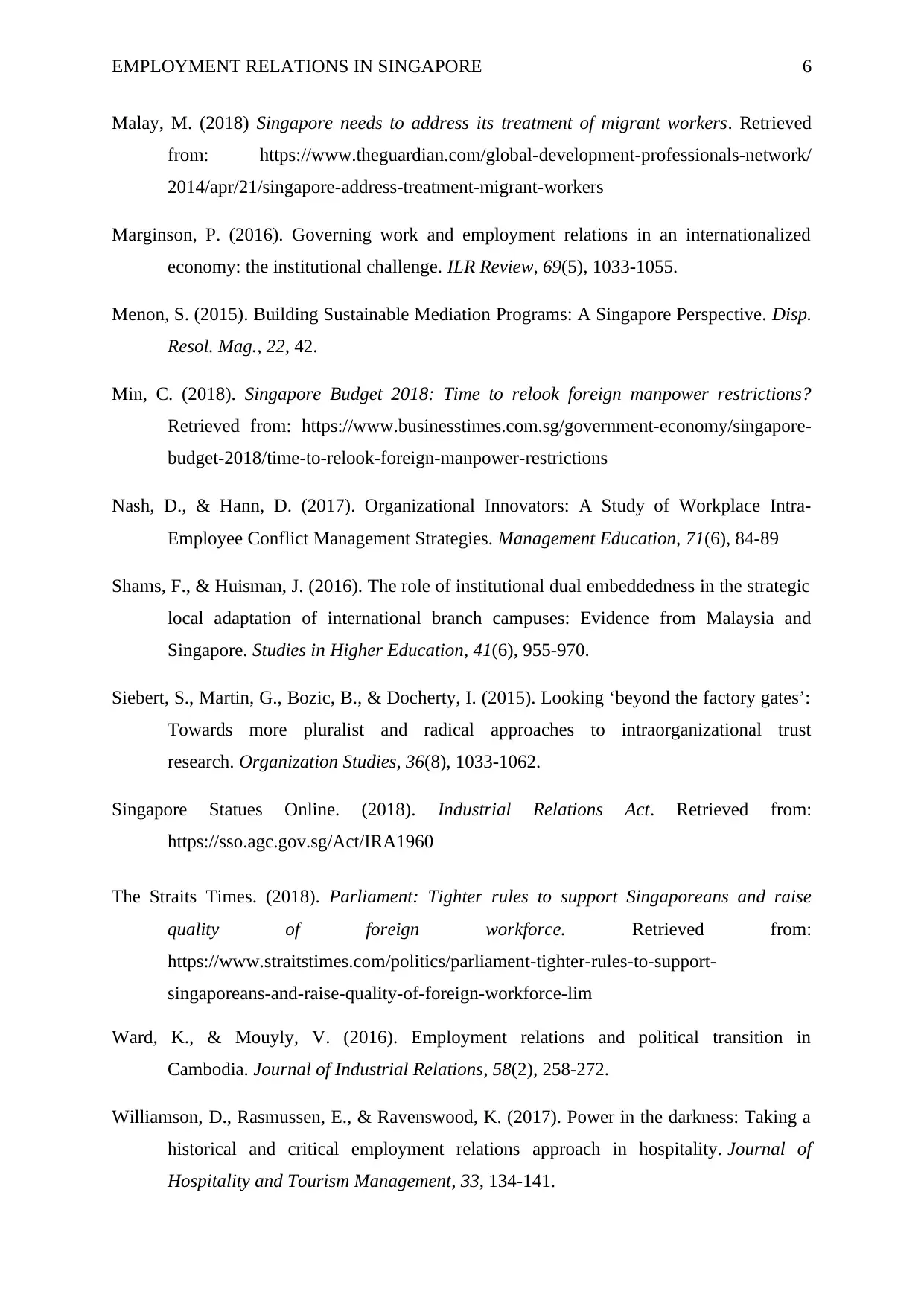
EMPLOYMENT RELATIONS IN SINGAPORE 6
Malay, M. (2018) Singapore needs to address its treatment of migrant workers. Retrieved
from: https://www.theguardian.com/global-development-professionals-network/
2014/apr/21/singapore-address-treatment-migrant-workers
Marginson, P. (2016). Governing work and employment relations in an internationalized
economy: the institutional challenge. ILR Review, 69(5), 1033-1055.
Menon, S. (2015). Building Sustainable Mediation Programs: A Singapore Perspective. Disp.
Resol. Mag., 22, 42.
Min, C. (2018). Singapore Budget 2018: Time to relook foreign manpower restrictions?
Retrieved from: https://www.businesstimes.com.sg/government-economy/singapore-
budget-2018/time-to-relook-foreign-manpower-restrictions
Nash, D., & Hann, D. (2017). Organizational Innovators: A Study of Workplace Intra-
Employee Conflict Management Strategies. Management Education, 71(6), 84-89
Shams, F., & Huisman, J. (2016). The role of institutional dual embeddedness in the strategic
local adaptation of international branch campuses: Evidence from Malaysia and
Singapore. Studies in Higher Education, 41(6), 955-970.
Siebert, S., Martin, G., Bozic, B., & Docherty, I. (2015). Looking ‘beyond the factory gates’:
Towards more pluralist and radical approaches to intraorganizational trust
research. Organization Studies, 36(8), 1033-1062.
Singapore Statues Online. (2018). Industrial Relations Act. Retrieved from:
https://sso.agc.gov.sg/Act/IRA1960
The Straits Times. (2018). Parliament: Tighter rules to support Singaporeans and raise
quality of foreign workforce. Retrieved from:
https://www.straitstimes.com/politics/parliament-tighter-rules-to-support-
singaporeans-and-raise-quality-of-foreign-workforce-lim
Ward, K., & Mouyly, V. (2016). Employment relations and political transition in
Cambodia. Journal of Industrial Relations, 58(2), 258-272.
Williamson, D., Rasmussen, E., & Ravenswood, K. (2017). Power in the darkness: Taking a
historical and critical employment relations approach in hospitality. Journal of
Hospitality and Tourism Management, 33, 134-141.
Malay, M. (2018) Singapore needs to address its treatment of migrant workers. Retrieved
from: https://www.theguardian.com/global-development-professionals-network/
2014/apr/21/singapore-address-treatment-migrant-workers
Marginson, P. (2016). Governing work and employment relations in an internationalized
economy: the institutional challenge. ILR Review, 69(5), 1033-1055.
Menon, S. (2015). Building Sustainable Mediation Programs: A Singapore Perspective. Disp.
Resol. Mag., 22, 42.
Min, C. (2018). Singapore Budget 2018: Time to relook foreign manpower restrictions?
Retrieved from: https://www.businesstimes.com.sg/government-economy/singapore-
budget-2018/time-to-relook-foreign-manpower-restrictions
Nash, D., & Hann, D. (2017). Organizational Innovators: A Study of Workplace Intra-
Employee Conflict Management Strategies. Management Education, 71(6), 84-89
Shams, F., & Huisman, J. (2016). The role of institutional dual embeddedness in the strategic
local adaptation of international branch campuses: Evidence from Malaysia and
Singapore. Studies in Higher Education, 41(6), 955-970.
Siebert, S., Martin, G., Bozic, B., & Docherty, I. (2015). Looking ‘beyond the factory gates’:
Towards more pluralist and radical approaches to intraorganizational trust
research. Organization Studies, 36(8), 1033-1062.
Singapore Statues Online. (2018). Industrial Relations Act. Retrieved from:
https://sso.agc.gov.sg/Act/IRA1960
The Straits Times. (2018). Parliament: Tighter rules to support Singaporeans and raise
quality of foreign workforce. Retrieved from:
https://www.straitstimes.com/politics/parliament-tighter-rules-to-support-
singaporeans-and-raise-quality-of-foreign-workforce-lim
Ward, K., & Mouyly, V. (2016). Employment relations and political transition in
Cambodia. Journal of Industrial Relations, 58(2), 258-272.
Williamson, D., Rasmussen, E., & Ravenswood, K. (2017). Power in the darkness: Taking a
historical and critical employment relations approach in hospitality. Journal of
Hospitality and Tourism Management, 33, 134-141.
Paraphrase This Document
Need a fresh take? Get an instant paraphrase of this document with our AI Paraphraser
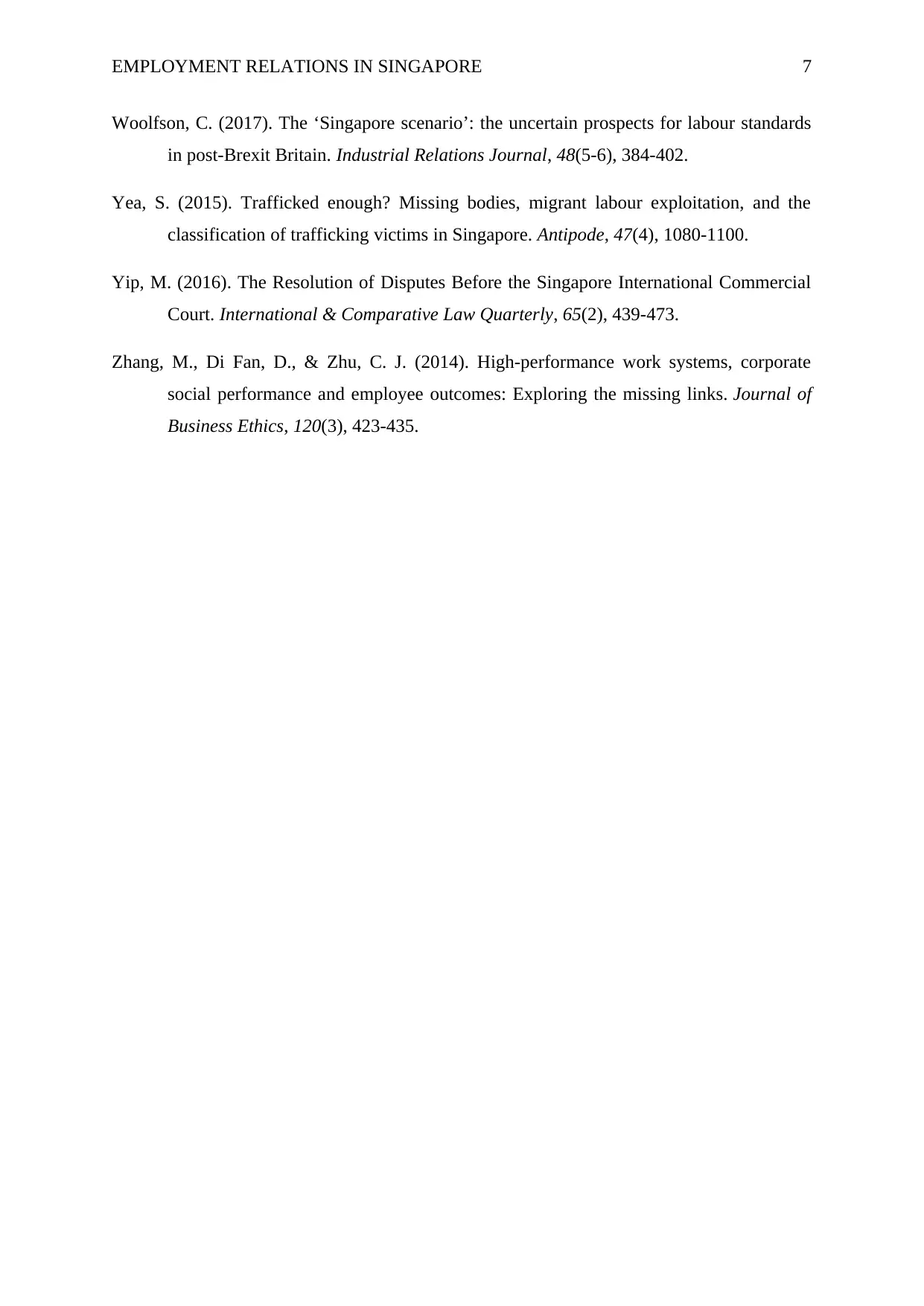
EMPLOYMENT RELATIONS IN SINGAPORE 7
Woolfson, C. (2017). The ‘Singapore scenario’: the uncertain prospects for labour standards
in post‐Brexit Britain. Industrial Relations Journal, 48(5-6), 384-402.
Yea, S. (2015). Trafficked enough? Missing bodies, migrant labour exploitation, and the
classification of trafficking victims in Singapore. Antipode, 47(4), 1080-1100.
Yip, M. (2016). The Resolution of Disputes Before the Singapore International Commercial
Court. International & Comparative Law Quarterly, 65(2), 439-473.
Zhang, M., Di Fan, D., & Zhu, C. J. (2014). High-performance work systems, corporate
social performance and employee outcomes: Exploring the missing links. Journal of
Business Ethics, 120(3), 423-435.
Woolfson, C. (2017). The ‘Singapore scenario’: the uncertain prospects for labour standards
in post‐Brexit Britain. Industrial Relations Journal, 48(5-6), 384-402.
Yea, S. (2015). Trafficked enough? Missing bodies, migrant labour exploitation, and the
classification of trafficking victims in Singapore. Antipode, 47(4), 1080-1100.
Yip, M. (2016). The Resolution of Disputes Before the Singapore International Commercial
Court. International & Comparative Law Quarterly, 65(2), 439-473.
Zhang, M., Di Fan, D., & Zhu, C. J. (2014). High-performance work systems, corporate
social performance and employee outcomes: Exploring the missing links. Journal of
Business Ethics, 120(3), 423-435.
1 out of 8
Related Documents
Your All-in-One AI-Powered Toolkit for Academic Success.
+13062052269
info@desklib.com
Available 24*7 on WhatsApp / Email
![[object Object]](/_next/static/media/star-bottom.7253800d.svg)
Unlock your academic potential
Copyright © 2020–2025 A2Z Services. All Rights Reserved. Developed and managed by ZUCOL.





